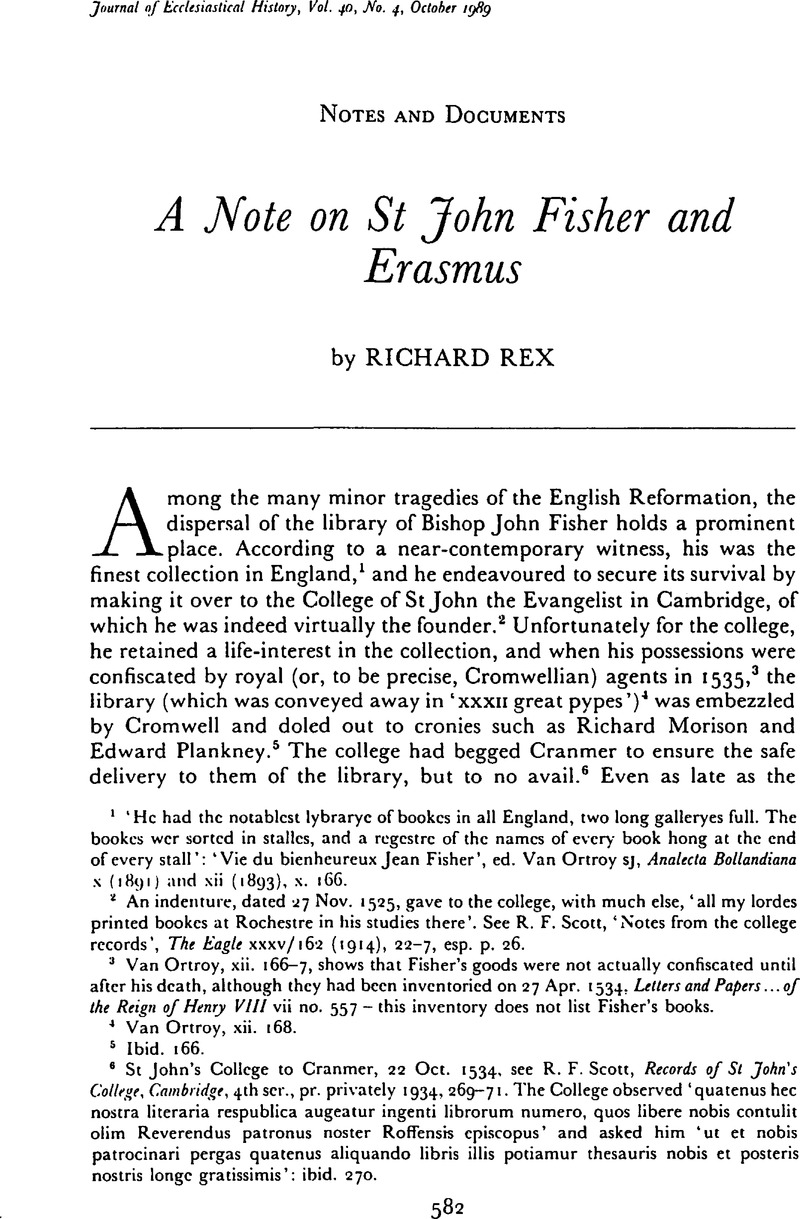No CrossRef data available.
Published online by Cambridge University Press: 25 March 2011

1 ‘He had the nocablcst lybraryc of bookes in all England, two long galleryes full. The bookes wer sorted in stalles, and a regestre of the names of every book hong at the end of every stall’: ‘Vie du bienheureux Jean Fisher’, ed. Van Ortroy sj, Armitela Bollandiana x (1891)Google Scholar and xii (1893), x. 166.
2 An indenture, dated 27 Nov. 1525, gave to the college, with much else, ‘all my lordes printed bookes at Rochestre in his studies there’. See Scott, R. F., ‘Notes from the college records’, The Eagle xxxv/162 (1914), 22–7Google Scholar, esp. p. 26.
3 Van Ortroy, xii. 166–7, shows that Fisher's goods were not actually confiscated until after his death, although they had been inventoried on 27 Apr. 1534, Letters and Papers … of the Reign of Henry VIII vii no. 557 - this inventory does not list Fisher's books.
4 Van Ortroy, xii. 168.
5 Ibid. 166.
6 St John's College to Cranmer, 22 Oct. 1534, see R. F. Scott, Records of St John's College, Cambridge, 4th scr., pr. privately 1934, 269–71 The College observed ‘quatenus hec nostra literaria respublica augeatur ingenti librorum numero, quos libere nobis contulit olim Reverendus patronus noster Roffensb cpiscopus’ and asked him ‘ut et nobis patrocinari pergas quatenus aliquando libris il lis potiamur thesauris nobis et posteris nostris longc gratissimis’: ibid. 270.
7 See the letter (drafted by Roger Ascham) from the Master and Fellows of St John's to the duke of Somerset, 21 Nov. 1547, pr. in Early Statutes of St John's Collegi, Cambridge, ed. J. E. B. Mayor, Cambridge 1859, p. x.
8 This volume was sold by Sotheby's in 1959, Sotheby's Sale Catalogue, for Mon. 23 Feb. 1959, 42Google Scholar, lot 212 and plate. I owe this reference to Mr David McKittcrick, Fellow-Librarian of Trinity College, Cambridge. I am endeavouring to trace the current owner of this volume, which was sold to the New York dealer John Fleming (Book-Auction Records 1958–1959, 349), and should be grateful to hear if anybody knows where it is.
9 Marc'hadour, G., ‘Erasme et John Fisher’, in Colloquia Erasmiana Turonensia, 2 vols, ed. J. C. Margolin, Toronto 1972, ii. 771–80Google Scholar, esp. pp. 774–7.
10 Letters and Papers iv/i no. 1939.10.
11 Ibid, vii no. 986.
12 See A. Kenny, ‘From hospice to college: Appendix 28’, The English Hospice in Rome: The Venerabile (sexcentenary issue) xxi (May 1962), 269Google Scholar. These could all be the same man - but even one example would be enough.
13 The books of Thomas Cranmer as archbishop of Canterbury are marked ‘Thomas Cantuarien’, in the hand of a secretary. See The Work of Thomas Cranmer, ed. Duffield, G. E. (Courtenay Library of Reformation Classics ii, 1964), 341.Google Scholar A good example is Cranmer's copy of Isychii in Levilicum, Basle 1527, now Cambridge University Library C*.10.19.
14 I would like to acknowledge here the help and advice of Mr McKitterick, who by a happy coincidence was about to visit the Houghton Library when I began to follow up Marc'hadour's lead, and kindly examined the volume for me.
15 In copies of samples as found in the Muniments of St John's College, Cambridge, D57.1, D57.2 and 057.17–19. I should like to thank Mr Malcolm Underwood, Archivist of St John's, for his assistance.
16 Erasmi Epistolae, 12 vols, ed. Alien, P.S., Oxford 1906–47. i. 477Google Scholar, ep. ccxxxvii, to Colct, 29 Oct. 1511. Allen's evidence was the inclusion by Erasmus in the 1529 edition of his letters of a passage, omitted in earlier editions, noting Fisher's suspicion that a translation of pseudo-Basil on Isaiah done for him by Erasmus was not original, but a reworking of a version by someone else. This is hardly compelling, and one is inclined to agree with E. E. Reynolds that ‘there is no decisive evidence’ for Allen's hypothesis, St John Fisher, London 1955, 48.Google Scholar
17 Marc'hadour, ‘Erasme et John Fisher’, 775–6.
18 Chantrainc, G., Erasme el Luther: libre el serf arbitre, Paris 1981, 463.Google Scholar
19 Levi, A. H. T., ‘The breakdown of scholasticism and the rise of evangelical humanism’, in The Philosophical Assessment of Theology: essays in honour of Frederick C. Copleslon, ed. Hughes, G. J., Georgetown 1987, 101–28Google Scholar, at p. 121; Chantraine, op. cit. 463. See below, n. 23.
20 Porter, H. C., ‘Fisher and Erasmus’, in Humanism, Reform and the Reformation: the career of Bishop John Fisher, ed. Bradshaw, B. and Duffy, E., Cambridge 1989, 81–101CrossRefGoogle Scholar, at pp. 93–4.
21 De Ventate Corporis et Sanguinis Christi in Eucharistia, Cologne 1527, bk 1, ch. ii, fo. 2 v, ‘vir admirabili iudicio’.
22 Ibid. bk v, ch. xxxvi, fo. 166v.
23 Ibid. bk. iv, ch. xxxii, fo. 126v, ‘Quantum vero tribuendum sit arbitrio libero, satis copiose docet Erasmus in triumphis illis quos egit de Luthero’. See also bk I, ‘Praelibatio ‘, fo. Ir.
24 Erasmi Epistolae vi. 505, Appendix XIX, Erasmus’ First Will, 22 Jan. 1527. Unfortunately, the 1533 version of the will is lost, and of course Fisher does not appear in the last will of 1536.
25 Ibid. ix. 4–6, ep. mmccclix, to Christopher von Stadion, 5 Aug. 1530.
26 Ibid. ix. 95, mmcdiii, from Erasmus Schets, 18 Dec. 1530. If this copy should survive, and anybody should know where it is, I would be most grateful for the information.
27 Letters and Papers viii no. 858, Fisher's Interrogation, 12 June 1535. Fisher received the letter via his brother Robert, who had shown it to Cromwell first.